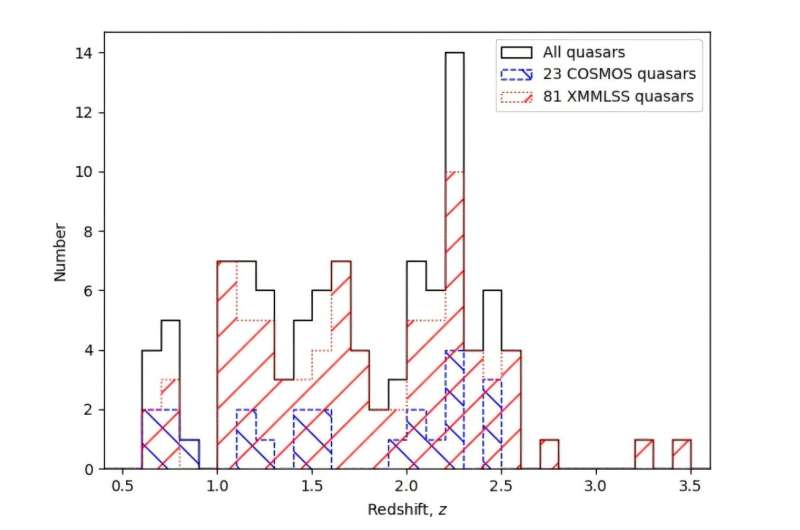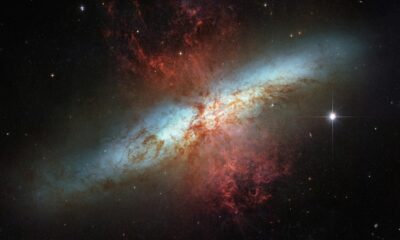Science
Astronomers Analyze 104 Quasars in Groundbreaking MIGHTEE Study

A team of astronomers from Rhodes University and collaborating institutions conducted an extensive analysis of 104 quasars identified through the MIGHTEE survey, utilizing data from the MeerKAT radio telescope in South Africa. This research, published on July 16, 2025, on the pre-print server arXiv, aims to deepen understanding of quasars and their various properties.
Quasars, or quasi-stellar objects, are among the universe’s most luminous and distant entities, playing a critical role in numerous astrophysical and cosmological studies. As active galactic nuclei (AGN), they emit electromagnetic radiation across a spectrum that includes radio, infrared, visible, ultraviolet, and X-ray wavelengths. The MIGHTEE survey, part of an ongoing effort to image the extragalactic sky, focuses on exploring the cosmic evolution of galaxies, including AGNs.
Insights into Quasar Characteristics
The research team, led by Sarah V. White, meticulously examined data from the COSMOS and XMM-LSS fields within the MIGHTEE survey. They focused on unobscured Type I quasars, which are characterized by broad emission lines. The selected quasars exhibited a range of redshifts between 0.6 and 3.41, with a median redshift of approximately 1.68.
The study’s findings revealed that the radio-loudness fraction for these quasars is estimated at 5%, aligning with previous observations from other quasar samples. Notably, the research indicated that the proportion of quasars with radio emissions dominated by AGN is lower than findings from other studies within the MIGHTEE sample. The astronomers hypothesized that this discrepancy may arise from the lower radio flux-density limit of the images, enhancing sensitivity to lower radio luminosities linked to star formation.
Moreover, the analysis highlighted a significant increase in the fraction of potential starburst galaxies among higher redshift quasars, jumping from 31-38% to 63% for sources at the highest redshifts. This trend suggests that identifying whether AGN dominate total radio emissions becomes increasingly complex as redshift increases.
Implications for Future Research
The authors of the study emphasize that the heightened incidence of starbursts in quasars at higher redshifts complicates the application of the “radio-excess” method for determining AGN dominance in radio emissions. They concluded by urging a reevaluation of methods for selecting and analyzing AGNs to account for these nuanced findings.
This research not only contributes to the understanding of quasar properties but also poses important considerations for future studies in astrophysics. The work was rigorously reviewed and fact-checked, reinforcing its credibility within the scientific community.
For more information, refer to the original study by Sarah V. White et al titled “MIGHTEE: A first look at MIGHTEE quasars,” available on arXiv.
-

 Entertainment3 months ago
Entertainment3 months agoAnn Ming Reflects on ITV’s ‘I Fought the Law’ Drama
-

 Entertainment4 months ago
Entertainment4 months agoKate Garraway Sells £2 Million Home Amid Financial Struggles
-

 Health3 months ago
Health3 months agoKatie Price Faces New Health Concerns After Cancer Symptoms Resurface
-

 Entertainment3 months ago
Entertainment3 months agoCoronation Street’s Carl Webster Faces Trouble with New Affairs
-

 Entertainment3 months ago
Entertainment3 months agoWhere is Tinder Swindler Simon Leviev? Latest Updates Revealed
-

 Entertainment4 months ago
Entertainment4 months agoMarkiplier Addresses AI Controversy During Livestream Response
-

 Science1 month ago
Science1 month agoBrian Cox Addresses Claims of Alien Probe in 3I/ATLAS Discovery
-

 World2 weeks ago
World2 weeks agoBailey Announces Heartbreaking Split from Rebecca After Reunion
-

 Health4 months ago
Health4 months agoCarol Vorderman Reflects on Health Scare and Family Support
-

 Entertainment4 months ago
Entertainment4 months agoKim Cattrall Posts Cryptic Message After HBO’s Sequel Cancellation
-

 Entertainment3 months ago
Entertainment3 months agoOlivia Attwood Opens Up About Fallout with Former Best Friend
-

 Entertainment2 weeks ago
Entertainment2 weeks agoCoronation Street Fans React as Todd Faces Heartbreaking Choice





















